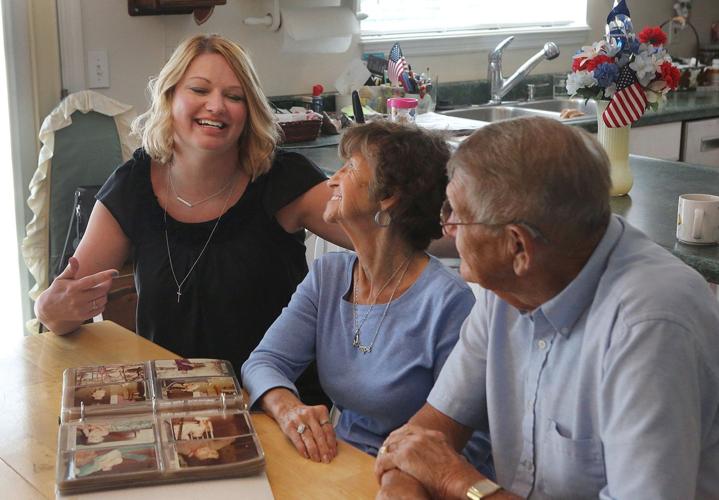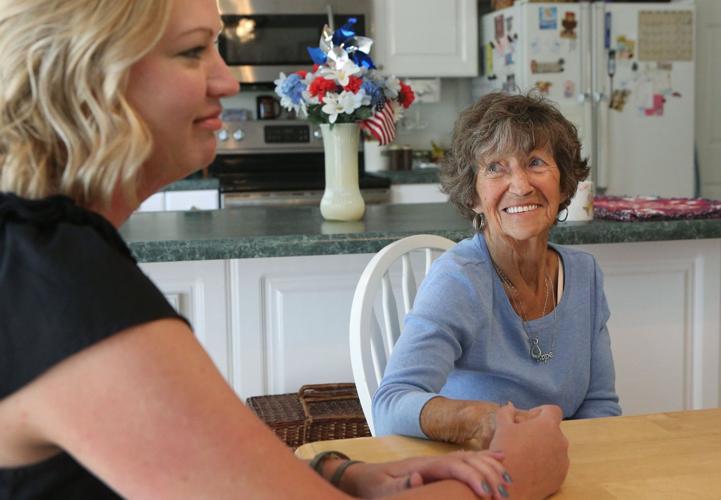First, her name was Baby Girl Jane Doe.

A photo of Amber Wankel taken by the Higgins family in 1978 has been in their scrapbook since the time when they tried to adopt her.
It was Aug. 19, 1977. Just a few hours old, she was dropped off at St. Joseph Health Center in St. Charles County by a man who said he was flagged down at mile marker No. 224 on Interstate 70 by a young couple in a gray van. They handed him a 7-pound baby wrapped in a blanket and took off, he said.
Soon, she would have a new name: Baby Hope.
ThatвАЩs the name Bob and Nella Higgins gave her when they brought her home. The couple had just become foster parents. They didnвАЩt plan to take in infants, but when the Division of Family Services called with a placement, they agreed. They fell in love with Hope, and they tried to adopt her.
вАЬAfter one week, I said: вАШI want this baby,вАЩвАЭ Nella recalled.
Nella is 78 now. Bob is 84. We were talking in their kitchen this month, flipping through an old photo album of HopeвАЩs first 10 months of life.
People are also reading…
She is 39 now and lives in Perry, Mo., with her husband and two children.
Her name is Amber Wankel. This is her story.
Search for answers
On June 5, Wankel made a discovery that changed her life.
For some time, she had been engaged in a search for her birth parents. Like many adoptees, she yearned for more information about her past. It wasnвАЩt like she had a bad childhood вАФ in fact, it was very good вАФ but there were unanswered questions.
Wankel was reared in Curryville, Mo., by Lee and Trudie Wankel. She graduated from Bowling Green High School in 1995. She went to college and got a job in the medical field. She knew the Wankels had adopted her when she was less than a year old, and that the foster family who first took care of her went to court to try to keep her. But details were scarce.
вАЬIt was a part of my life that I really didnвАЩt know a lot about,вАЭ Wankel says.
A DNA search hadnвАЩt helped much in identifying her birth family. Her blond hair and blue eyes give away her German heritage. But the closest relatives she could find through a DNA database were distant cousins. She turned to Google and newspaper archive searches. There, Wankel came across a story headlined: вАЬCouple Denied Custody of Foster ChildвАЭ in the April 26, 1979, edition of the Post-Dispatch. It was written by none other than Joseph Pulitzer IV, scion of the famous newspaper family.
The story recounts how the Missouri Supreme Court the Higginses in an adoption battle with the state of Missouri. A split court decided to keep the former ward of the state with her second foster family, in part because the Wankels had cared for Amber since she was about 10 months old.
The day after Wankel read the newspaper article, she Googled вАЬRobert and Nella Higgins.вАЭ Dozens of possibilities showed up. She got it right on the first call.
Nella answered. She yelled to Bob, who was watching television in the other room.
Hope had been found.
вАЬI couldnвАЩt believe it,вАЭ Bob said. вАЬShe never left us.вАЭ
Indeed, throughout the HigginsesвАЩ home are pictures of Baby Hope. Wankel would soon find that the couple had looked for her, also. In every home they ever had, pictures of Hope hung next to their own children.
For years, Nella had worn a silver necklace with the word вАЬHope.вАЭ
SheвАЩs wearing it as they sit next to each other in the HigginsesвАЩ Warren County kitchen. Wankel grabs her hand. All these years, theyвАЩve lived just a couple of hours away.
вАЬItвАЩs been 39 years,вАЭ Bob says. вАЬEvery year since then sheвАЩs been a part of our life.вАЭ
They met for the first time in June at StefaninaвАЩs pizzeria in Wentzville.
The Higginses brought baby pictures. For the first time, Wankel knew that as a baby, she looked just like her own two children, Nealee and Nola, both named without any knowledge of a Nella in her life.

A photo of the Higgins family with baby Amber Wankel from 1978 is in their scrapbook. The family is, from left: Theresa, 17 at the time; baby Amber with Nella; Paul, 14 at the time; and Bob.
вАЬMy kidsвАЩ names are one of the biggest wows to me,вАЭ Wankel says. вАЬItвАЩs like they are named after Nella. GodвАЩs hand in this journey for sure.вАЭ
Foster families to the rescue
It could have been so much worse.
The police report of the first day of WankelвАЩs life describes the too-frequent scene of a young couple realizing they arenвАЩt ready for parenthood and abandoning their baby. A man who identified himself as Thomas Rogers of Auxvasse, Mo., brought the then-2-hour-old baby to the hospital, saying he was flagged down by a gray van with out-of-state plates bearing white and green letters.
The man calling himself Rogers spoke with a deputy. St. Peters police Officer Kevin Kost found the story suspicious. Eventually, he tracked down a Thomas Rogers in Auxvasse. He didnвАЩt fit the description of the man who dropped the baby off at the hospital. He knew nothing about a baby .
To this day, Kost believes it was a ruse, that the man might have been the actual father of Baby Jane Doe, or somebody close to the family.
вАЬIвАЩm glad they didnвАЩt leave me in a Dumpster,вАЭ Wankel said. She agreed to tell her story now, not just because she still holds out a small hope that her biological parents can be found, but because she hopes others in a similar situation will think before abandoning a baby.
Since 2002, Missouri has had a which allows parents to drop off an unwanted newborn baby at a hospital, fire station or police station without fear of prosecution, as long as they havenвАЩt abused the child. Illinois passed its law in 2001. Experts say such laws each year who otherwise might have been abandoned.
вАЬThere are people out there who want babies,вАЭ Wankel says. вАЬThere are good foster families out there.вАЭ
Amber Wankel had two of them.
вАЬI feel like I found something I wasnвАЩt looking for,вАЭ said the woman once known as Baby Hope. вАЬI have two good families now.вАЭ















